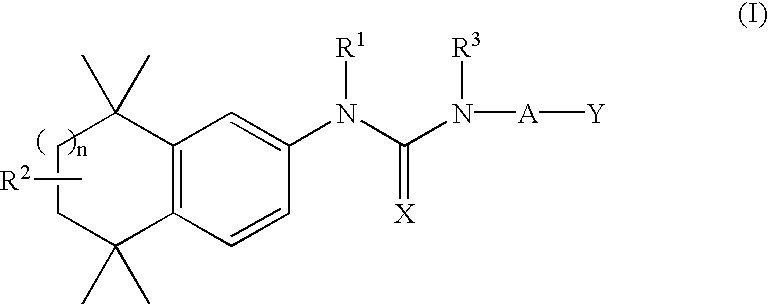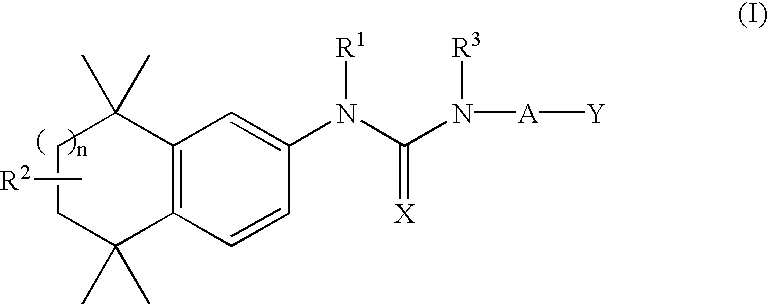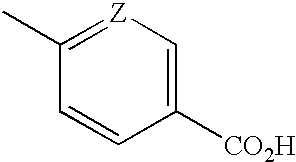Substituted urea retinoid agonists
a technology of retinoid agonists and substituted urea, which is applied in the preparation of urea derivatives, drug compositions, amide active ingredients, etc., can solve the problems of limited therapeutic use of retinoid in diseases other than cancer, disability and death, and patient death
- Summary
- Abstract
- Description
- Claims
- Application Information
AI Technical Summary
Benefits of technology
Problems solved by technology
Method used
Image
Examples
example 1
5.1. Example 1
Synthesis of 5,5,8,8-Tetramethyl-5,6,7,8-Tetrahydro-Naphthalen-2-Ylamine (1)
A solution of 5,5,8,8-tetramethyl-5,6,7,8-tetrahydro-naphthalene (20.0 g, 106.2 mmole) in 85 ml of acetic anhydride at 0° C. was treated with 12.2 mL of acetic acid followed by 11.1 mL of nitric acid (70%) and was allowed to warm to room temperature. After 24 hours the reaction mixture was poured onto 300 mL ice-water and extracted with three 150 mL portions of ether. The combined organic extracts were washed with four 100 mL portions of 15% aqueous sodium hydroxide solution, two 200 mL portions of water and one 200 mL portion of saturated aqueous sodium chloride solution. The organic phase was dried, filtered and concentrated in vacuo, giving 23.93 g (97%) of 6-nitro-5,5,8,8-tetramethyl-5,6,7,8-tetrahydro-naphthalene (3) as a pale yellow solid.
1.4 g of Pd / C (10%) was added to a solution of 6-nitro-5,5,8,8-tetramethyl-5,6,7,8-tetrahydro-naphthalene (3) (23.93 g, 102.6 mmole) in 1 L of ethanol. ...
example 2
5.2. Example 2
Synthesis of 4-[3-Phenethyl-3-(5,5,8,8-Tetramethyl-5,6,7,8-Tetrahydro-naphthalen-2-yl)-Ureido]-Benzoic Acid (5)
A solution of 5,5,8,8-tetramethyl-5,6,7,8-tetrahydro-naphthalen-2-ylamine (1) (0.5 g, 2.46 mmole) in 20 mL of dicloromethane was treated successively with 0.51 mL of triethylamine (1.5 eq.) and 0.33 mL of phenylacetyl chloride (1 eq.), stirred at room temperature for two hours and then diluted with an additional 20 mL of dichloromethane. The organic solution was washed with two 50 mL portions of water and one 50 mL portion of saturated aqueous sodium chloride solution. The organic phase was dried over MgSO4, filtered and concentrated in vacuo to give 790 mg (100%) of phenylacetic acid (5,5,8,8-tetramethyl-5,6,7,8-tetrahydro-naphthalen-2-yl)-amide (7) as a pale yellow foam.
A solution of phenylacetic acid (5,5,8,8-tetramethyl-5,6,7,8-tetrahydro-naphthalen-2-yl)-amide (7) (790 mg, 2.46 mmole) in 20 mL diethyl ether (ether) was treated with 400 mg of lithium alumi...
example 3
5.3. Example 3
Synthesis of 4-[3-(2-Methoxy-Ethyl)-3-(5,5,8,8-Tetramethyl-5,6,7,8-Tetrahydro-Naphthalen-2-yl)-Ureido]-Benzoic Acid (13)
Following the procedure described in Example 2, but substituting methoxyacetyl chloride for phenylacetyl chloride in the first step, provided 4-[3-(2-methoxy-ethyl)-3-(5,5,8,8-tetramethyl-5,6,7,8-tetrahydro-naphthalen-2-yl)-ureido]-benzoic acid (13). MS (EI): (M+−1):423.
PUM
| Property | Measurement | Unit |
|---|---|---|
| affinity | aaaaa | aaaaa |
| structure-activity relationship | aaaaa | aaaaa |
| elasticity | aaaaa | aaaaa |
Abstract
Description
Claims
Application Information
 Login to View More
Login to View More - R&D
- Intellectual Property
- Life Sciences
- Materials
- Tech Scout
- Unparalleled Data Quality
- Higher Quality Content
- 60% Fewer Hallucinations
Browse by: Latest US Patents, China's latest patents, Technical Efficacy Thesaurus, Application Domain, Technology Topic, Popular Technical Reports.
© 2025 PatSnap. All rights reserved.Legal|Privacy policy|Modern Slavery Act Transparency Statement|Sitemap|About US| Contact US: help@patsnap.com



